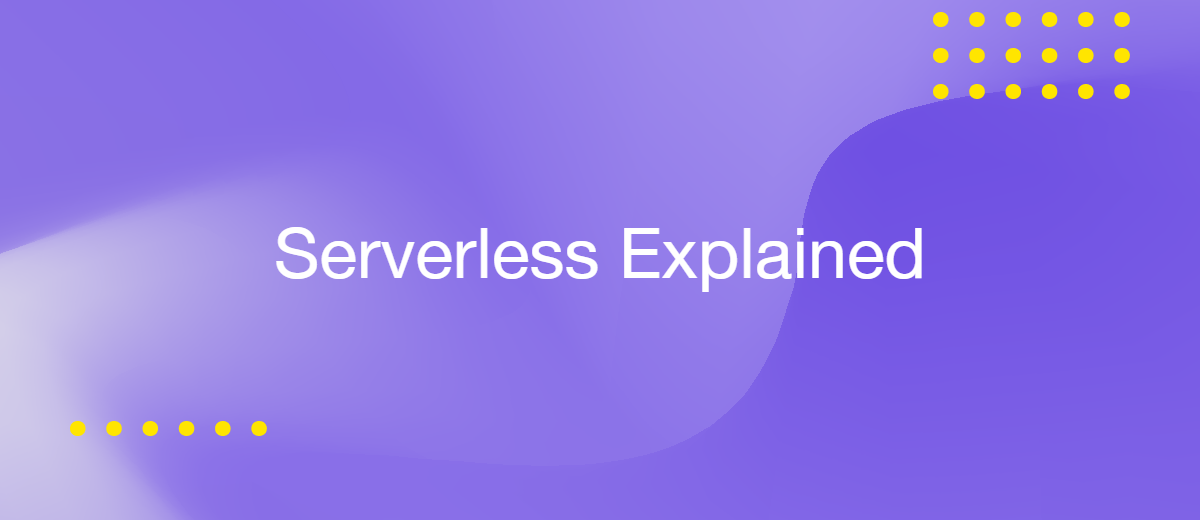Serverless Explained: Key Concepts and Benefits
These days, server management is no longer an integral part of software and application development. It has been replaced by a new approach called serverless architecture or serverless computing. This innovation has fundamentally changed the principles of software development and maintenance, making the process much more productive, flexible, and convenient for all involved.
In our new article, you'll learn about this method and its main components (FaaS and BaaS, cloud providers). We'll also discuss the most significant pros and cons of serverless, as well as practical application scenarios.
What Is Serverless Architecture
Serverless architecture is a method of developing and managing software without the use of a dedicated server. It eliminates the need for developers to purchase/rent, configure, and maintain physical hardware to run their applications.
Instead, they use the necessary infrastructure in the cloud, accessing it from cloud service providers via APIs. The serverless architecture supports automatic resource provisioning and distribution, as well as fault tolerance and scalability management.
This technology allows developers to rent software tools and interfaces from a provider to run and maintain their software. They don't interact with hardware devices, delegating these tasks to a cloud service.

Serverless architecture is currently gaining widespread adoption in a number of promising industries related to artificial intelligence, big data analytics, and the Internet of Things (IoT). Major tech corporations, including Amazon, Google, and Microsoft, offer serverless computing services to their clients.
Thanks to its advantages, serverless architecture optimizes development processes and accelerates time-to-market for IT products. It also reduces software maintenance complexity and improves cost-effectiveness. This allows developers to reduce their costs associated with creating and scaling applications.
How Serverless Works Behind the Scenes
Let's examine the main components of this development method.
BaaS
BaaS (backend-as-a-service) is one of the key service models that will enable developers to access cloud computing services in 2025. It involves outsourcing all backend components used in software development and maintenance.
BaaS solution providers handle databases, host services, and maintain cloud storage. They also handle a number of other application-specific processes, such as sending push notifications, user authentication, remote updates, and so on.
The BaaS model allows developers to delegate all server functions to the provider, while they themselves only focus on writing code and developing/updating the software interface.
FaaS
FaaS (function-as-a-service) is another cloud computing model in which individual program functions are executed remotely in the cloud without the need to launch and maintain virtual machines.
- Automate the work of an online store or landing
- Empower through integration
- Don't spend money on programmers and integrators
- Save time by automating routine tasks
For these purposes, providers offer dedicated cloud platforms with fault tolerance and automatic scalability. Developers utilize these resources to run various application functions during the development/testing phase or after launch.
The FaaS model doesn't use server processes; instead, it uses trigger events to invoke functions. Common trigger events include HTTP API calls, database updates, file uploads, scheduled actions, and so on.
This serverless model is especially popular for developing scalable web apps, as it allows for easier and faster scaling of code and the implementation of microservices. FaaS services are charged only when features are used, saving clients' resources.
Cloud Providers
A cloud provider is a company that delivers tools and services for developing and maintaining software in accordance with the principles of serverless architecture.
Cloud providers offer solutions that give developers remote access to various resources necessary for creating and deploying an IT product.
Typical cloud provider services include leasing virtual infrastructure (IaaS), software tools (SaaS), and ready-to-use platforms (PaaS), which are out-of-the-box solutions.
The cloud services allow for flexible resource scaling based on developers' needs. Providers guarantee high performance and stability of their IT solutions, as well as compliance with advanced security standards.
Benefits for Developers and Businesses
The benefits of serverless computing have made this method widely adopted in the modern IT industry. Among the most significant are:
- Scalability. Computing resources allocated by cloud providers are automatically scaled based on current tasks and workload levels. The flexibility and elasticity of these systems allow them to quickly deploy and scale down production environments as needed.
- Increased productivity. Delegating infrastructure and data management processes to cloud providers increases development productivity. The development team can devote more time to the software's business logic, speeding time to market.
- Cost efficiency. Another important advantage of the serverless approach over the traditional one is cost minimization. Serverless applications only use resources when they are needed, which is especially beneficial for new IT products or products with fluctuating demand.
- Ease of deployment. The serverless method provides high flexibility for deploying software in various environments. This allows developers to quickly and seamlessly adapt their products to market conditions, investor requirements, and other stakeholders.
- Simple synchronization and integration. Hosting databases and other software components in the cloud significantly speeds up and simplifies their synchronization. This ensures data format compatibility and connection stability. Serverless platforms also offer native integrations with numerous third-party systems and services.
Use Cases and Limitations
In this section of the article, we'll discuss serverless use cases and the potential limitations of this development method. The main scenarios for using serverless architecture are:
- Orchestration of large data sets. Serverless applications effectively automate the collection, classification, and analysis of any information, including big data.
- Automate a wide range of trigger-based tasks using a chain of functions executed on the cloud provider's side (FaaS model). Examples include backups, data import/export, and more.
- Software security. Serverless computing is often used to scan software and its components for vulnerabilities or misconfigurations.
- Asynchronous data processing is used to run background processes in an app. These could include file downloads, sending user notifications, and so on.
- Continuous integration (CI) and continuous delivery (CD). Serverless architecture is in demand for automating CI/CD pipelines.
- Automatic scaling of websites and applications, allowing for the efficient optimization of software development, launch, and maintenance processes.
On the other hand, certain disadvantages of serverless architecture limit its applicability for a number of scenarios. These include the following factors:
- Vendor lock-in. Most cloud providers use a proprietary service delivery model. This creates difficulties for developers when switching providers, as they may need to rewrite the source code and completely reconfigure the software.
- Execution time limitation. Vendors typically limit the maximum execution time of application functions. On average, this period ranges from a few seconds to several minutes. Therefore, their solutions are not suitable for software with long-running tasks.
- Startup latency. Automated serverless functions often have higher startup latency than traditional server-based architectures. This limits their use for applications that require instant response.
- Lack of session state. Serverless architecture operates without the ability to maintain session state. This precludes its use for applications that require this feature or that perform long-running operations.
Bottom Line
Serverless architecture is one of the priority approaches to web application development in 2025. It allows developers to delegate a number of processes and tasks related to backend software functionality to cloud providers. This optimizes scalability, reduces project costs, and brings a number of other benefits.
Serverless computing is in high demand in the most advanced tech industries, including artificial intelligence, the Internet of Things, and big data analytics. While it offers a wide range of application scenarios, it is not without its limitations.
Routine tasks take a lot of time from employees? Do they burn out, do not have enough working day for the main duties and important things? Do you understand that the only way out of this situation in modern realities is automation? Try Apix-Drive for free and make sure that the online connector in 5 minutes of setting up integration will remove a significant part of the routine from your life and free up time for you and your employees.


